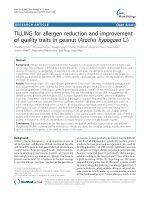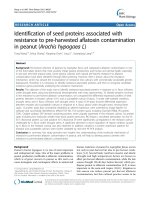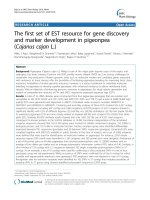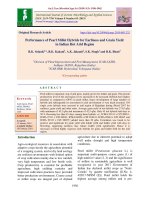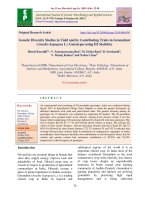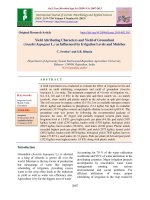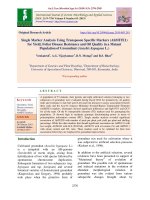Screening of genotypes on basis of chlorophyll content, nitrate reductase activity and kernel yield in groundnut (Arachis hypogaea L.)
Bạn đang xem bản rút gọn của tài liệu. Xem và tải ngay bản đầy đủ của tài liệu tại đây (337.06 KB, 6 trang )
Int.J.Curr.Microbiol.App.Sci (2018) 7(8): 4645-4650
International Journal of Current Microbiology and Applied Sciences
ISSN: 2319-7706 Volume 7 Number 08 (2018)
Journal homepage:
Original Research Article
/>
Screening of Genotypes on Basis of Chlorophyll Content, Nitrate Reductase
Activity and Kernel Yield in Groundnut (Arachis hypogaea L.)
Mohammed Anwar Ali1*, Anjan Kumar Pal2, Apurba Pal2,
Ananya Baidya2 and Sunil Kumar Gunri3
1
Department of Crop Physiology, Acharya N.G. Ranga Agricultural University, Agricultural
College Bapatla, Andhra Pradesh – 522101, India
2
Department of Plant Physiology, 3Department of Agronomy, F/Ag, Bidhan Chandra Krishi
Viswavidyalaya, Nadia, West Bengal – 741252, India
*Corresponding author
ABSTRACT
Keywords
Groundnut, Chlorophyll
content, Nitrate reductase
activity and Kernel yield
Article Info
Accepted:
26 August 2018
Available Online:
10 September 2018
Nineteen groundnut genotypes were screened for physiological characters, chlorophyll
content and nitrate reductase activity at 30 DAS (pre-anthesis) and 60 DAS (post-anthesis)
along with kernel yield during the Pre-summer. Leaf chlorophyll content and nitrate
reductase activity plays a considerable role in plant metabolism. Nitrate reductase is one of
the most important enzymes in the assimilation of exogenous nitrate, the predominant form
of nitrogen available to green plants growing in soil, helps in maintaining the plant
photosynthetic machinery, which in turn results in accumulation of metabolites for storage
i.e., kernel yield. High significant differences were observed in genotypes for chlorophyll
content and nitrate reductase activity in relation to kernel yield.
Introduction
Groundnut (Arachis hypogaea L.) is
considered as one of the most important
legume and oil seed crops, which is valued not
only for edible oil and protein for human
beings but also as fodder for livestock
(Sharma and Sardana, 2012). Bently Glass
(1961) aptly stated, “Life is a photochemical
phenomenon.” The chemical compounds most
important in conversion of light energy into
chemical energy are the pigments that exist
within the chloroplast/chromatophores of
plant. The chlorophylls, the green pigment of
the chloroplast, are the most important
photosynthetic plant pigments. In groundnut
(water use efficiency) is governed by the
photosynthetic capacity which is dependent on
leaf nitrogen status. Leaf nitrogen status is
ultimately reflected in chlorophyll content
(Vasanthi et al., 2005).
Nitrate reductase (NR), the first in the series
of enzymes that reduces nitrogen to ammonia.
NR is a metalloflavo protein inducible enzyme
which catalyses the reduction of nitrate to
4645
Int.J.Curr.Microbiol.App.Sci (2018) 7(8): 4645-4650
nitrite. It acts as a rate limiting step and
regulatory enzyme in the pathway i.e., NO3¯to
NO2¯, and its activity often controls the
assimilation rate of nitrate.
Out of two different pools for nitrate in plant
tissues i.e., storage and metabolic pools, only
nitrate of the metabolic pool functions as a
substrate for NR and contributes to organic
nitrogen.
Increase in the chlorophyll content and nitrate
reductase activity could improve the yield of
plants. The present experiment carried out to
find such genotypes, which poses higher
chlorophyll content, nitrate reductase activity
and high kernel yield.
Estimation of chlorophyll
The chlorophyll content in the leaf sample was
estimated as per Arnon (1949), at 30 DAS
(pre-anthesis) and 60 DAS (post-anthesis).
Further chlorophyll „a‟ (chl. „a‟), chlorophyll
„b‟ (chl. „b‟), total chlorophyll and chlorophyll
„a‟/chlorophyll „b‟ (chl. „a‟/chl. „b‟) were
calculated as per formulae in the method.
mg of chlorophyll „a‟/g of fresh tissue = [(12.7
x A663) – (2.69 x A645)] x [V/1000 x W]
mg of chlorophyll „b‟/g fresh tissue = [(22.9 x
A645) – (4.68 x A663)] x [V/1000 x W]
mg of total chlorophyll/g of fresh tissue =
[(20.2 x A645) + (8.02 x A663)] x [V/1000 x W]
Materials and Methods
The field experiment was conducted in Incheck Farm, „C‟ Block, BCKV, Kalyani,
Nadia. The soil texture of the experimental
plot was sandy loam with pH 6.9-7.0.
Nineteen genotypes of groundnut were
subjected to yield trial in the year 2015 (Presummer). The genotypes collected from
AICRP on Groundnut, BCKV, Kalyani, India.
The design of the experiment was randomized
block design (RBD), replicated thrice. A
uniform spacing of 30 cm row to row and 15
cm plant to plant was followed in each case.
Appropriate plant protection measures along
with other standard cultural practices were
followed to raise a healthy crop.
Physiological traits such as, i. Chlorophyll
content of leaf (mg g-1 fresh weight), ii.
Nitrate reductase activity in leaves (mM nitrite
formed hour-1 g-1 fresh weight) were estimated
from the leaf sample collected at 30 and 60
days after sowing (DAS) in each genotype.
Kernel yield were taken from five (5)
randomly selected plants per replicate for each
of the genotype.
Where, V = Volume of the extract (ml), W =
Fresh weight of tissue (g), A = Absorbance.
Measurement of nitrate reductase activity
Extraction of nitrate reductase (NR) and the
estimation of enzyme activities in leaves was
assayedas per Jaworski (1971), at 30 DAS
(pre-anthesis) and 60 DAS (post-anthesis). NR
activity is expressed as mM nitrite formed
hour-1 g-1 fresh weight.
Statistical analysis
The mean data on pod yield were subjected to
statistical analysis following randomized
block design (RBD) by INDOSTAT version
7.1 software. Least Significant Difference
(LSD) at P≤ 0.05 statistically compared the
mean values.
Results and Discussion
The content of chlorophyll „a‟, chlorophyll
„b‟, chlorophyll „a‟/„b‟ as well as total
chlorophyll and the activity of nitrate
reductase enzyme in the leaf of nineteen
4646
Int.J.Curr.Microbiol.App.Sci (2018) 7(8): 4645-4650
genotypes were assayed at 30 and 60 DAS.
The analysis of variance exhibited highly
significant variation among the genotypes for
these physiological characters.
Leaf chlorophyll content
The content of chlorophyll „a‟, chlorophyll „b‟
and total chlorophyll in the leaves of nineteen
genotypes of groundnut furnished in (Table 1)
at 30 DAS varied from 0.98-1.41, 0.41-0.61
and 1.43-1.89 mg g-1 fresh weight of leaf,
respectively. The genotype INS-1-2013-8 and
INS-1-2013-6 recorded the highest content of
leaf chlorophyll among all the genotypes at
this growth stage (30 DAS). INS-1-2013-8
also had the highest content of chlorophyll „a‟
(1.41), total chlorophyll (1.89) and chlorophyll
„a‟/„b‟ (2.94 mg g-1) respectively. The mean
values for chlorophyll „a‟, chlorophyll „b‟ and
total chlorophyll in the leaves of nineteen
genotypes of groundnut at 60 DAS ranged
from 0.10-1.26, 0.28-0.53 and 1.16-1.77 mg
g-1 fresh weight of leaf, respectively. Out of all
the genotypes, INS-1-2013-8 registered the
highest mean for these three characters.
It might be noted that this genotype also
recorded the highest kernel yield. However, in
the present experiment, the ratio of
chlorophyll „a‟ to chlorophyll „b‟ ranged from
1.99-2.94 and from 2.22-3.38 at 30 and 60
DAS, respectively. Perusal of the data further
indicated that the chlorophyll content in all the
genotypes except one (INS-1-2013-5)
decreased at 60 DAS as compared to 30 DAS.
This might indicate the onset of leaf
senescence at the time of post-flowering
remobilization of photo-assimilates.
Nitrate reductase activity
Nitrate reductase (NR) catalyses the reduction
of nitrate to nitrite, which is the first step in
assimilation of nitrate absorbed by the roots
into organic compounds in plants. It is an
important enzyme in nitrogen metabolism of
the plants. The mean values presented in
(Table 2) indicates that the activity of nitrate
reductase in the leaf at 30 and 60 DAS ranged
from 1.56-4.68 mM nitrite formed hour-1 g-1
fresh weight and from 1.25-2.65 mM nitrite
formed hour-1 g-1 fresh weight at 30 and 60
DAS, respectively. The genotype INS-1-201326 registered the highest activity of NR in leaf
at both the growth stages 4.68 and 2.65mM
nitrite formed hour-1 g-1 fresh weight at 30 and
60 DAS respectively, whereas INS-1-2013-9
recorded the lowest mean 1.56 and 1.25 mM
nitrite formed hour-1 g-1 fresh weight at 30 and
60 DAS respectively.
The pattern of changes further indicated that
the NR activity in the leaf reduced at 60 DAS
in comparison with that at 30 DAS in all the
genotypes except in INS-1-2013-2, which
showed slight increase. These results are in
line with the results of Sung and sun, 1990.
Thus, the activity of nitrate reductase enzyme
was found to be higher in pre-anthesis stage
than in post-anthesis pod filling stage. It might
be concluded that the plants mainly depended
on the remobilization of nitrogen reserve
during pod filling stage as indicated by the
results in the present experiment. The
observation was more or less consistent with
the early finding of Thibodeau and Jaworski,
(1975) reported a drop in nitrate reductase
activity in soybean leaves during postflowering stage.
Kernel yield
The mean values for kernel yield per plant
(Figure 1) ranged from 6.85 g to 17.22 g.
Among all the genotypes, INS-1-2013-8
registered the highest kernel yield (17.22 g)
and it was followed by INS-1-2013-5 (15.55
g) and INS-1-2013-4 (13.13 g). The genotype
INS-1-2013-1 had the lowest kernel weight
per plant (6.85 g) and it was followed by INS1-2013-7 (7.71 g).
4647
Int.J.Curr.Microbiol.App.Sci (2018) 7(8): 4645-4650
Table.1 Chlorophyll content in the leaves of nineteen genotypes of
Groundnut (mg g-1 fresh weight)
Genotypes
Chloroph
yll – ‘a’
30 DAS
Chlorophy
Total
ll –‘b’
Chlorophy
ll
Chlorophy
ll
‘a’/‘b’
Chlorophy
ll–‘a’
60 DAS
Chlorophy
Total
ll–‘b’
Chlorophy
ll
Chlorophy
ll
‘a’/‘b’
INS-1-2013-1
1.22
0.61
1.83
1.99
0.86
0.29
1.16
2.93
INS-1-2013-2
1.15
0.43
1.58
2.70
0.87
0.30
1.17
2.94
INS-1-2013-3
1.17
0.53
1.70
2.23
0.98
0.33
1.30
2.97
INS-1-2013-4
0.98
0.45
1.43
2.20
1.00
0.33
1.33
3.03
INS-1-2013-5
1.12
0.55
1.67
2.05
1.26
0.41
1.67
3.08
INS-1-2013-6
1.30
0.54
1.84
2.40
1.05
0.39
1.44
2.72
INS-1-2013-7
1.05
0.46
1.51
2.28
1.05
0.36
1.41
2.93
INS-1-2013-8
1.41
0.48
1.89
2.94
1.24
0.53
1.77
2.35
INS-1-2013-9
1.21
0.42
1.63
2.88
1.12
0.45
1.56
2.57
INS-1-201310
INS-1-201311
INS-1-201312
INS-1-201313
INS-1-201323
INS-1-201326
INS-1-201328
INS-1-201333
INS-1-201334
INS-1-201335
S.E. (m)±
1.28
0.47
1.75
2.73
1.23
0.42
1.65
2.90
1.10
0.45
1.54
2.50
0.91
0.41
1.32
2.22
1.19
0.48
1.67
2.47
1.03
0.38
1.41
2.74
1.32
0.50
1.81
2.70
1.12
0.44
1.57
2.54
1.30
0.50
1.81
2.59
1.13
0.40
1.54
2.84
1.05
0.41
1.47
2.53
1.10
0.34
1.43
3.28
1.17
0.53
1.70
2.21
0.10
0.40
1.40
2.50
1.28
0.50
1.70
2.55
0.99
0.41
1.39
2.44
1.14
0.46
1.60
2.48
1.06
0.32
1.38
3.38
1.26
0.53
1.78
2.39
0.90
0.28
1.18
3.37
0.072
0.036
0.080
0.241
0.077
0.026
0.080
0.304
0.147
0.073
0.163
0.490
0.156
0.054
0.162
0.616
C.D.
(P=0.05)
(DAS= Days After Sowing)
4648
Int.J.Curr.Microbiol.App.Sci (2018) 7(8): 4645-4650
Table.2 Nitrate reductase activity in the leaves of nineteen genotypes of groundnut (data
expressed as mM nitrite formed hour-1 g-1 fresh weight)
Genotypes
INS-1-2013-1
INS-1-2013-2
INS-1-2013-3
INS-1-2013-4
INS-1-2013-5
INS-1-2013-6
INS-1-2013-7
INS-1-2013-8
INS-1-2013-9
INS-1-2013-10
INS-1-2013-11
INS-1-2013-12
INS-1-2013-13
INS-1-2013-23
INS-1-2013-26
INS-1-2013-28
INS-1-2013-33
INS-1-2013-34
INS-1-2013-35
S.E. (m)±
C.D. (P=0.05)
(DAS-Days After Sowing, NR-Nitrate Reductase)
NR activity
30 DAS
60 DAS
2.28
2.17
1.99
2.02
3.73
1.30
1.92
1.30
3.48
1.29
4.25
1.65
3.85
1.45
3.90
1.35
1.56
1.25
2.77
2.52
2.81
2.18
2.85
2.10
2.44
1.61
2.84
2.06
4.68
2.65
3.22
2.45
2.56
2.10
2.98
1.88
3.66
2.54
0.207
0.208
0.420
0.421
Fig.1 Kernel yield in nineteen genotypes of groundnut
4649
Int.J.Curr.Microbiol.App.Sci (2018) 7(8): 4645-4650
The genotypes showed significant differences
among them in respect of kernel yield and its
all attributes. Three genotypes, INS-1-2013-8,
INS-1-2013-5 and INS-1-2013-4 were the top
ranking genotypes in respect of kernel
yield/plant. The leaf chlorophyll content as
well as the nitrate reductase activity of leaf
decreased at post-anthesis pod filling stage as
compared to pre-anthesis stage. Thus, the
genotypes mainly depended on remobilization
of nitrogen reserve and photo-assimilates
during pod filling stage rather than current
photosynthetic and nitrogen assimilation
activity.
Acknowledgement
Authors are grateful to AICRP on Groundnut,
Kalyani, India, for providing genotypes.
Author is also thankful to Dr. Sunil Kumar
Gunri for extending the facilities at field.
References
Arnon, D.I. 1949. Copper enzyme in isolated
chloroplast polyphenol oxidase in Beta
vulgaris. Plant Physiology.24: 1-15.
Glass, B. 1961. In summary, A symposium on
light and life. John Hopkins press,
Baltimore. 817-912.
Jaworski, E.G. 1971. Nitrate reductase assay
in intact plant tissues. Biochemical and
Biophysical Research Communications.
43: 1274-1279.
Sharma, P and Sardana, V. 2012. Effect of
growth regulating substances on the
chlorophyll,
nitrate
reductase,
leghaemoglobin content and yield in
groundnut (Arachis hypogaea L.). The
Bioscan. 7(1): 13-17.
Sung, F.J.M and Sun, Y.W. 1990. Seasonal
patterns of nitrate reductase and
nitrogenase activities in Arachis
hypogaea. Field Crops Research.25:
215-222.
Thibodeau, P.S and Jaworski, E.G. 1975.
Patterns of nitrogen utilization in the
soybean. Planta. 127: 133-147.
Vasanthi, R.P., Sreelatha Devi, G., Babitha,
M and Sudhakar, P. 2005. Inheritance
of leaf chlorophyll content in groundnut
(Arachis hypogaea L.). Indian Journal
of Genetics. 65(3): 196-198.
How to cite this article:
Mohammed Anwar Ali, Anjan Kumar Pal, Apurba Pal, Ananya Baidya and Sunil Kumar
Gunri. 2018. Screening of Genotypes on Basis of Chlorophyll Content, Nitrate Reductase
Activity and Kernel Yield in Groundnut (Arachis hypogaea L.). Int.J.Curr.Microbiol.App.Sci.
7(08): 4645-4650. doi: />
4650

